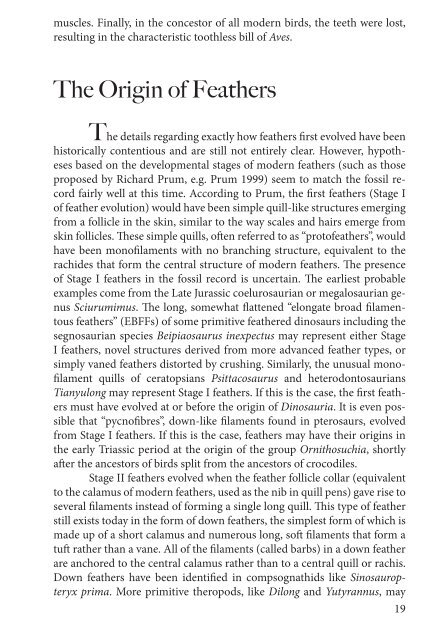You also want an ePaper? Increase the reach of your titles
YUMPU automatically turns print PDFs into web optimized ePapers that Google loves.
muscles. Finally, in the conces<strong>to</strong>r of all modern <strong>birds</strong>, the teeth were lost,<br />
resulting in the characteristic <strong>to</strong>othless bill of Aves.<br />
The Origin of Feathers<br />
The details regarding exactly how feathers first evolved have been<br />
his<strong>to</strong>rically contentious <strong>and</strong> are still not entirely clear. However, hypotheses<br />
based on the developmental stages of modern feathers (such as those<br />
proposed by Richard Prum, e.g. Prum 1999) seem <strong>to</strong> match the fossil record<br />
fairly well at this time. According <strong>to</strong> Prum, the first feathers (Stage I<br />
of feather evolution) would have been simple quill-like structures emerging<br />
from a follicle in the skin, similar <strong>to</strong> the way scales <strong>and</strong> hairs emerge from<br />
skin follicles. These simple quills, often referred <strong>to</strong> as “pro<strong>to</strong>feathers”, would<br />
have been monofilaments with no branching structure, equivalent <strong>to</strong> the<br />
rachides that form the central structure of modern feathers. The presence<br />
of Stage I feathers in the fossil record is uncertain. The earliest probable<br />
examples come from the Late Jurassic coelurosaurian or megalosaurian genus<br />
Sciurumimus. The long, somewhat flattened “elongate broad filamen<strong>to</strong>us<br />
feathers” (EBFFs) of some primitive feathered <strong>dinosaurs</strong> including the<br />
segnosaurian species Beipiaosaurus inexpectus may represent either Stage<br />
I feathers, novel structures derived from more advanced feather types, or<br />
simply vaned feathers dis<strong>to</strong>rted by crushing. Similarly, the unusual monofilament<br />
quills of cera<strong>to</strong>psians Psittacosaurus <strong>and</strong> heterodon<strong>to</strong>saurians<br />
Tianyulong may represent Stage I feathers. If this is the case, the first feathers<br />
must have evolved at or before the origin of Dinosauria. It is even possible<br />
that “pycnofibres”, down-like filaments found in pterosaurs, evolved<br />
from Stage I feathers. If this is the case, feathers may have their origins in<br />
the early Triassic period at the origin of the group Ornithosuchia, shortly<br />
after the ances<strong>to</strong>rs of <strong>birds</strong> split from the ances<strong>to</strong>rs of crocodiles.<br />
Stage II feathers evolved when the feather follicle collar (equivalent<br />
<strong>to</strong> the calamus of modern feathers, used as the nib in quill pens) gave rise <strong>to</strong><br />
several filaments instead of forming a single long quill. This type of feather<br />
still exists <strong>to</strong>day in the form of down feathers, the simplest form of which is<br />
made up of a short calamus <strong>and</strong> numerous long, soft filaments that form a<br />
tuft rather than a vane. All of the filaments (called barbs) in a down feather<br />
are anchored <strong>to</strong> the central calamus rather than <strong>to</strong> a central quill or rachis.<br />
Down feathers have been identified in compsognathids like Sinosauropteryx<br />
prima. More primitive theropods, like Dilong <strong>and</strong> Yutyrannus, may<br />
19



